I LIVE on an ancient highway. It???s called the Great North Road. For many hundreds of years it???s been the main arterial link between the capital cities of two countries ??? England and Scotland. It is woven into history, folklore and legend. Dick Turpin galloped up it to his death. The Gododdin rode down it to theirs. Bonnie Prince Charlie got part way down, bottled out and turned back. The Leather Boys drove all the way up and all the way down in one day from the Ace Cafe on the North Circular. I consider it a privilege to be able to sit in my front room and watch traffic pass by . . .
 Pedants might argue that the historical Great North Road actually lies four miles to the east of my house ??? in the North Yorkshire village of Barton ??? and that it is now known as the A167. They might insist that this other road???s claim to fame is well documented by numerous authorities ??? including Sir Walter Scott, who had Rob Roy pass along its rutted length between Northallerton and Darlington. Not only that, they might argue, but the Scots and English fought one of their many battles on the same stretch of road ??? the Battle of the Standard ??? a bleak memorial now marking the spot. Who won? Google it. I???ve a foot in both camps.
Pedants might argue that the historical Great North Road actually lies four miles to the east of my house ??? in the North Yorkshire village of Barton ??? and that it is now known as the A167. They might insist that this other road???s claim to fame is well documented by numerous authorities ??? including Sir Walter Scott, who had Rob Roy pass along its rutted length between Northallerton and Darlington. Not only that, they might argue, but the Scots and English fought one of their many battles on the same stretch of road ??? the Battle of the Standard ??? a bleak memorial now marking the spot. Who won? Google it. I???ve a foot in both camps.
But the Great North Road split at Boroughbridge, above York, the easterly branch taking the direct route to Northallerton, Darlington, Durham, Newcastle and the Scottish border. The westerly branch followed the Roman road of Dere Street to link up with the trans-Pennine Roman road to Carlisle (now the A66) at Scotch Corner, before veering back through Barton to rejoin the easterly route on the outskirts of Darlington.
When the roads were numbered during the 1920s, it was the westerly loop that became the A1 ??? the primary link between the ancient capitals of Londinium and Din Eidyn. Northallerton and Rob Roy might have enjoyed the droving, coaching, battle-weary version of the Great North Road, but Scotch Corner and my front door ended up on the motorised Roman version. I???m quite happy with that.
Why am I writing this? Because it???s my day off and the mist is low on the hills ??? that???s one reason. Another reason is that this historic road that we now take for granted was carved by feet, hooves and wagon wheels. It was imprinted on the landscape by people like us ??? people who moved about using their own muscles. The Great North Road was one of the first and most spectacular public rights of way. And it still is.
Not too long ago, the Great North Road was a gaping gash of mud that stretched from London???s Smithfield to Edinburgh. During wet weather, that gash became hundreds of yards in width as feet, hooves and wheels sought firmer ground away from the ruts, puddles and sprawling mire. Pilgrims, soldiers, peasants, vagabonds, rebellious armies, drovers, geese, cattle, coaches, kings and clerics ??? in a nutshell, humanity and its larder ??? passed along its length. The Great North Road wasn???t planned ??? it evolved. It wriggled, it shrank, it expanded, it changed its route ??? sometimes by design and occasionally by accident. Then someone invented tar macadam (can???t remember what his name was) and all that changed.
So I sit in my front room with a branch of the Great North Road literally within shouting distance, wondering whether or not to pull on my boots and get out there. I???ll tell you what else I can see through the window ??? the stub of St Cuthbert???s Cross, at the side of the road next to the bus stop. The story of St Cuthbert???s posthumous wanderings are well known, but for anyone not familiar, here???s a very brief precis.
St Cubby (local nickname) was buried in the monastery on the holy island of Lindisfarne. In 875 the Vikings invaded and the monks fled, taking with them Cubby???s casket. The monks wandered for many years bearing the saint???s remains, finally interring them in what is now Durham Cathedral. But at every place the bones rested, a cross was raised. The stump of Barton???s cross is still there. So my branch of the Great North Road has been a highway since Viking times at least. I like the thought of that.
Half a mile to the west lies what could be described as the New Great North Road ??? the A1M motorway. This has little to endear itself to lovers of wilderness and solitude, with the exception of the rather pertinent fact that it is a very convenient route to Scotland. And another half mile west lies the Roman road of Dere Street.
Aha . . . another north-south arterial link carved by feet, hooves and wagon wheels, this one running from York to Edinburgh. Dere Street is the continuation of the Roman road called Ermine Street, which runs from London to York. Perhaps, together, Dere Street and Ermine Street were the original Great North Road. Now, though, it???s just a straight stretch of asphalt that strikes between fields to Piercebridge, a delightful village on the banks of the Tees which is built on the shell of a Roman fort.
So I pull on my boots, dodge a bus on the Great North Road, climb over a stile, and within ten minutes am gazing down upon traffic hurtling along a four-lane version of an ancient highway. And I think about those guys down there in their 38-tonne wagons, white vans and tiny cars. And I wonder how many spare a thought for the millions of people who have made the same journey, many of them on foot or horseback, pulling their cloaks about them as daylight fades and rain streams in from the Pennines.
Another ten minutes later, after following a pleasant grassy track through fields of green stuff that I don???t know the name of (but which looks like brassica seedlings so might well be oil seed rape), I reach Dere Street ??? now incorporated into the British roads system as the B6275. Dere Street is an Anglo-Saxon name. The Romans would have know it as an ???iter???, with a number attached: such as Iter III or Iter VI. I think the Anglo-Saxons win on this one. They certainly beat the 1920s civil service offering of B6275.
Again the trucks, vans and cars whizz past me. Again I wonder if any of their drivers spare a thought for the foreign soldiers who carved this road in an almost perfect line from Scotch Corner to Piercebridge then on through County Durham and into Northumberland, throwing magnificent bridges across the Tees, Wear, Tyne and any number of smaller rivers so the legions could march into the land of the Picts, give them a hammering then get hammered themselves.
I wander the mile back to Barton, conscious of the fact I am placing my boots in the footsteps of soldiers from Africa, the Middle East, Spain, Gaul and many other countries ??? sent to this insignificant place by bureaucrats in distant Rome. I cross my own personal section of the Great North Road, along which horse-drawn coaches once hurtled from Scotch Corner to Darlington, give Cubby???s stump a friendly nod, wish the Vikings good health just to be on the safe side, open my front door, pour myself a beer and get pleasantly drunk.
Does anyone else contemplate stuff like this? Or do we all live in the present, passively accepting that our roads were made by blokes in fluorescent jackets who pop back occasionally, disrupt the traffic with their temporary lights, lay some more asphalt,??then bugger off to upset someone else?
Is there such a thing as the past or is there only the present? Does it matter or does it not? Am I a better person for thinking about these things than the bloke in green overalls driving the Eddie Stobart lorry who thunders past me with his mind on Stuart Pearce???s ability to manage the England team? Dunno.
Ancient highways; the Great North Road; millions of people making millions of journeys across 2,000 years, stamping their feet into mud and stone and stamping an identity on a nation. Sorry, two nations. Does it actually matter? Perhaps I should drink less.
FURTHER READING AND VIEWING:
- For the absolute complete history of the Great North Road, right down to its milestones, culverts and bridges, visit this amazing website ??? A1-The Great North Road
- What Wikipedia has to say about the Great North Road
- Dick Turpin. We all know who he was, don???t we? Wasn???t he in those Carry On films? For the real Dick Turpin, as opposed to Sid James???s Big Dick Turpin, visit Stand and Deliver
- Y Gododdin, a poem attributed to the poet Aneirin, tells of a band of elite Celtic warriors who rode from their kingdom, north of the Wall, down Dere Street in a suicidal attempt to drive the Anglo-Saxons from their lands. The final and fateful conflict took place at Catraeth ??? generally accepted to be the present-day Catterick. It???s still rough in Catterick, mind
- The Leather Boys (1964) is one of British cinema???s classic biking films, starring Rita Tushingham (but it had to), Colin Campbell, a very young Dudley Sutton (Lovejoy???s mate), and a very young Johnny Briggs (Mike Baldwin from Corrie). The race up and down the Great North Road is not on YouTube, but a preliminary burn-up along the North Circular from the Ace Cafe certainly is. They don???t make films like this any more
- St Cuthbert. Apparently he was a nice guy. Read all about him, and his posthumous wanderings, here
- The Battle of the Standard, fought on the Great North Road two miles from Northallerton, was the first major battle between Norman England and Scotland. The result was England 1, Scotland 0. Mind you it was a home game





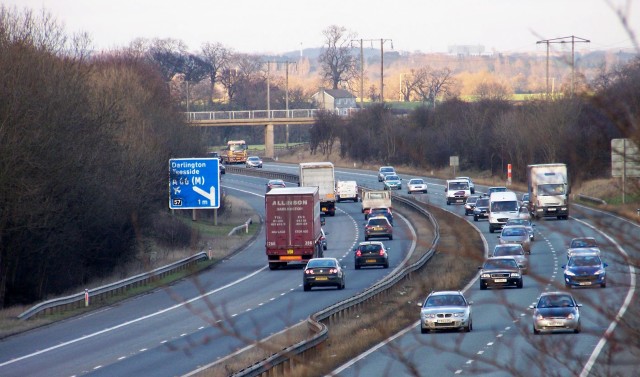

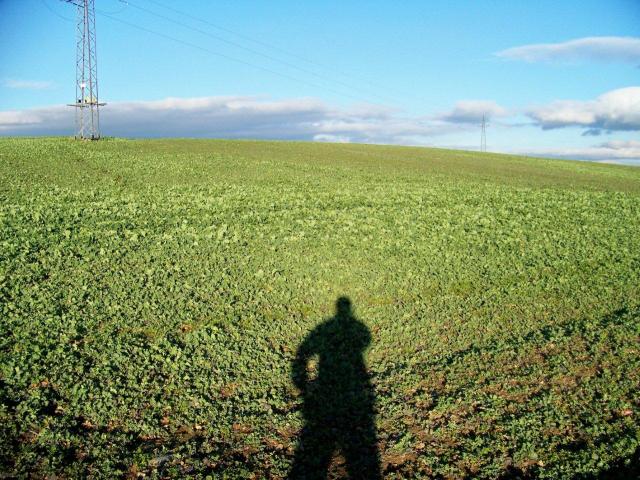























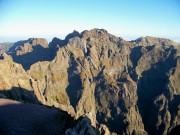


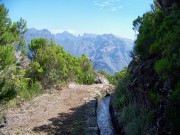
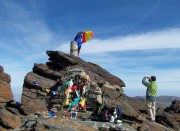

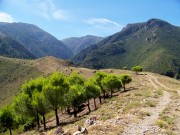
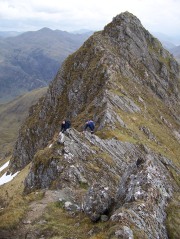
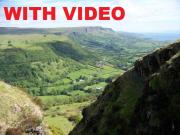
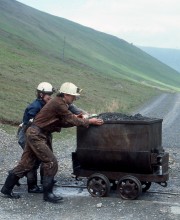
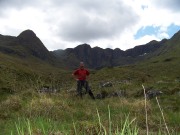

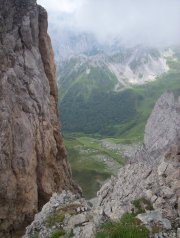
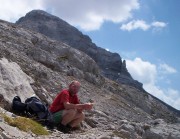
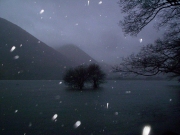
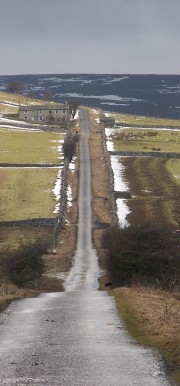

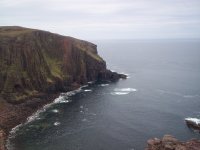
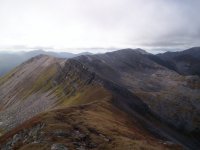
and right back to the “cup and ring” carvers trade routes ?
as for :- “Is there such a thing as the past or is there only the present ?”
Titus Lucretius Carus (c.99-55 BCE)
On the Nature of Things…
No single thing abides; but all things flow.
Fragment to fragment clings-the things thus grow
Until we know and name them. By degrees
They melt, and are no more the things we know.
Globed from the atoms falling slow or swift
I see the suns, I see the systems lift
Their forms; and even the systems and the suns
Shall go back slowly to the eternal drift.
You too, oh earth-your empires, lands, and seas -
Least with your stars, of all the galaxies,
Globed from the drift like these, like these you too
Shalt go. You are going, hour by hour, like these.
Nothing abides. The seas in delicate haze
Go off; those mooned sands forsake their place;
And where they are, shall other seas in turn
Mow with their scythes of whiteness other bays.
The seeds that once were we take flight and fly,
Winnowed to earth, or whirled along the sky,
Not lost but disunited. Life lives on.
It is the lives, the lives, the lives, that die.
They go beyond recapture and recall,
Lost in the all-indissoluble All:-
Gone like the rainbow from the fountain’s foam,
Gone like the spindrift shuddering down the squall.
Flakes of the water, on the waters cease!
Soul of the body, melt and sleep like these.
Atoms to atoms-weariness to rest -
Ashes to ashes-hopes and fears to peace!
O Science, lift aloud your voice that stills
The pulse of fear, and through the conscience thrills -
Thrills through the conscience with the news of peace -
How beautiful your feet are on the hills!
Hi Danny
What a wonderful poem. That???s one I haven???t come across before. It???s a poem that should be read a couple of times, then read again slowly and savoured.
And yes, the cup and ring carvers??? trade routes ??? Barningham Moor, a centre of Bronze Age culture, slap bang on what is now the A66 from Scotch Corner. The Romans didn???t carve the first routes up England and across the Pennines, they were only improving on what others had done before. It???s fascinating stuff.
Cheers, Alen McF
great post, great read
Thanks for that. It’s always gratifying to know there’s someone out there.
wow that’s amazing…. a road carved and hammered by the feet, by constantly stamping on that same route… to anybody who’d know the history of how that road was made, would probably stop by and spend some time to feel, digest and look back..Great post of yours.
Thank you. I have this fascination for how things developed. We tend to assume that simple things such as roads have always been there, or that they are the product of a modern society (which I suppose many are). But the old established routes across countries and continents, many have their origins buried in the times before history was recorded. I like that thought.
That was absolutely fascinating. I really love the way you weave the human side of things into the outdoors, no matter the subject. Just as well they’re not still fighting on the A1 these days but the electronic signs would be fun to imagine: “Cross Border Skirmish, JNCT 24. Expect Delays”.
Ha ha. And what about those stupid messages they put up when they haven???t any real information to offer, like: ???Have you checked your fuel???? and ???Don???t take drugs and drive.??? There would be things like: ???Have you fed your horse???? and ???Don???t gallop after a lunchtime session.??? Or a variation on one you see more and more these days: ???Gateshead 56 miles ??? two-and-a-half days.???
Good post and a worthy read. As for the question, I don’t know whether everyone does it. I know I do. As an example, Magdalena Mountain’s located along the old route between the Rio Grande River in New Mexico westward to what’s now Springerville, AZ. It’s named Magdalena because of a formation on the face that gives the appearance of a cameo. The village of Magdelena’s named for it. I don’t recall when I wrote this because I’ve spent so many hours studying that mountainside during pauses in travel.
Magdalena
Men long
Without a woman
See them everywhere
Hard men wandered
Pecked the earth
Water holes
Streambeds
Mountain faces
For gold and silver
Lead and copper
Fought among themselves
Conquistador
Fought Tigua
Acoma and Zuni
Yankee fought rebel
Fought Mexican
Fought Apache
Fought Navajo
Fought renegade
Fought partner
Fought an unforgiving
Land
They found her here
Thirsty minds
Quenched
In a woman face
A cameo
Soft
On mountain face
Serene
A face of peace
Magdalena
Old Jules
Jules, that’s a magnificent poem. And thank you for answering my question so eloquently. The trouble is, you’ve given me a sudden urge to wander in a country I’ve never thought of wandering in before. Perhaps one day I’ll get over there.
Cheers, Alen McF
“Does anyone else contemplate stuff like this?”
I think I’m quite lucky, because I’ve often found myself drifting off into historical musings during the dogs’ daily constitutional at Bothwell Castle. There’s just about never anyone else there at early o’clock, and there’s an undeniable presence about the place. It does set you thinking.
Oh, and as a point of dubious interest, “the A1 by Scotch Corner” gets a mention in Jethro Tull’s “Too old to Rock and Roll”. Which is sort of historical too, if you think aboot it.
:0)
Thank you for that point of dubious interest, Scott, which I did indeed find interesting. Jethro Tull is one of those groups I should have delved into about 30 years ago (perhaps even 40) but never did. I’ll look into “the A1 by Scotch Corner” connection because I find Scotch Corner an intriguing place ??? mainly because everyone has heard of it but there’s absolutely nothing there except a hotel and a roundabout. I’ve a feeling Watford Gap might fall into the same category, even fulfilling the criteria of being immortalised in song (Roy Harper). There might be scope for a book in this: famous places where nothing happens and nothing exists but people write songs about them.
Cheers now. Alen.
Hi Alen.
As ever I envy your ability to tell a great story that also happens to be educational! As for your question, I think about it everytime I walk along an old drovers road, or follow a right of way society path, or pick up a part of the road that General Wade ploughed through the Scottish hinterlands in an effort, as our national anthem suggests, “rebellious Scots to crush”. The scary thing is that I sometimes find myself talking to them!!…….J
I must confess, John, I had your last comment in mind when I wrote this, the one about sitting on a pile of rocks that was once a one-roomed cottage in the middle of nowhere and wondering how people survived. And I thought: Hmmm . . . That could apply to these old roads too. So thank you for providing the inspiration. As for talking to them, I think that???s pretty natural. It???s when they start talking back it might be time to worry.
Alen McF
An interesting read Alen. Does anyone else contemplate stuff like this? I think anyone who wanders our countryside must think about those who have gone before at one time or another. I often think about how tracks or trails came into being but have to be honest have not given any great thought to our major road networks. My interest always seems to stray to the people close to the beginning of and beyond our recorded history such as the hunter-gatherers, Bronze, Iron Age etc.
The Green Trod over Cronkley Fell in Upper Teesdale being a case in point. Some say it is prehistoric and was an ancient drovers road from Thirsk to Alston (unconfirmed) others simply refer to it as a prehistoric drove road. Eden valley to Teesdale perhaps? Either way like you say, it was ancient tracks such as this that eventually developed into our major roads.
Hi David. The Green Trod???s a new one on me. I???ve just Googled it and it looks like something that???s worthy of further exploration. Drovers??? roads interest me but I know little about them, other than they were used to feed our cities up until the advent of the railways. That???s another way of life that???s disappeared almost without trace. I???ll have a walk up there sometime. I did a bit of walking in that area about 15 years ago with my son, before he went through that phase of not wanting to be seen enjoying himself with his father. So it???s time I revisited it.
Cheers, Alen.
A good time to revisit would be in May. That way you would be able to see the rare Spring Gentian flowers as well.
Thanks for that tip, David. I???m not too familiar with wild flowers, but I???ve just taken a look at spring gentian and they???re really beautiful. So spring it is.
Cheers, Alen.
Loved the post Alen. As you know, this stuff fascinates me and I for one think about it a lot of the time. I keep meaning to do a similar piece on the Fosse Way that bisects Leicestershire. McAdam didn’t invent tarmacadam, but he did promote the use of hard rather than soil based surfaces for roads. Tarmacadam came later as an evolution of McAdam’s ideas.
I thought this one would interest you, Colin. I meant to put a link into McAdam’s Wikipedia page but forgot. Mind you, it comes as a great disappointment to learn he was not the inventor of tarmacadam. It???s funny you should say that because I learnt only the other day, in a conversation at work, that contrary to popular opinion Thomas Crapper was not the inventor of the flush toilet ??? his greatest achievement was the ball-cock. So many historical myths have come to light with the access to knowledge the internet has brought. I???m not sure whether it???s a good thing or not. By the way, I???ll be interested to read your Fosse Way piece when you write it. That???s another thing I???ve heard of but know little about.
Cheers, Alen
Ever since I was young and I first heard the name the.Great North Road, I have thought it such a descriptive name. When young, and living south of the border, It brought to my mind images of an expansive, wild land, just waiting to be explored. Now, when returning home to the Highlands it is evocative of (the best!) wild landscapes that I look forward to embracing again.
Your pandering reminded me of a poem that I read years ago (and can not find, despite searching on the ‘net) about a calf winding it’s weary way home (back to the farm) at the end of the day. The poem described how a road came into being, and why it is not straight. The original line of the road was a animal path made by the calf meandering along as it returned to the farm. This line on the ground was followed by the villagers as they walked between neighbouring villages (as many of us follow sheep or deer paths when on the hill!), then was used by horse and cart, until it was eventually surfaced. I think I read this poem on a poster or plaque somewhere, and it struck a chord as my hubby was an roads engineer at the time.
Hi Sheila. I too heard the name Great North Road as a child, and although I lived on the opposite side of the country it evoked a certain romance; it had a nobleness about it that suggested adventure and history. And so many great writers have woven it into their plots. As well as Sir Walter Scott, in one of his novels John Buchan describes a car chase from London to Scotland that takes place on the Great North Road ??? an incident in Boroughbridge comes to mind. I can???t remember which book ??? but it wasn???t the Thirty-Nine Steps. Well, that???s two great writers I can think of, anyway. Can???t help you with the poem I???m afraid. That???s a new one on me. But if you do eventually find it, you???ll have to let me know.
Cheers, Alen.
Alen – a very interesting insight and background to a road I spent a lot of time on over the years. It is spending so much time on roads like this that keeps away from heading out to the hills !!
That is of course the down side, Mark. I don’t think there’s a way round that other than moving to the hills or taking up paragliding (which I saw a sign for while driving through Kirkby Stephen the other day). I think I’ll stick to the car.
Cheers, Alen.
Hi Alen, yes some of of this history stuff I find fascinating. For instance the Battle of Rannerdale where the Cumbrian Norsemen defeated the Normans. Did it happen ? Were there reprisals?
I think i once read that a viking called Eric the Red was defeated on Stainmore. Was he a different faction as presumably a lot of the locals must have been viking descent. Must try and find out more……..
Hi Greg. The Battle of Rannerdale ??? I had to look that one up. It???s a fascinating tale and one I’ve not come across before. In fact, I don’t think I’ve ever been in Rannerdale so I might put that on my list. As for Erik . . . I read some of the Icelandic sagas a long time ago (there was no entertainment in south Cumbria in those days) and it was Erik Bloodaxe, the last king of Northumbria, who was killed on Stainmore. But as with many of these tales, the more you look into it on the internet the less clear it becomes. Some sources have him dying in Spain.
Either way, I don???t think Stainmore was a very safe place in those days, what with Norwegians and Danes settling all around, displacing the Britons and Angles ??? and then the Normans coming in and thumping everybody.
All the best, Alen
I remember reading of The Great North Road when exploring history books and it always seemed it would be an adventure to travel on such – long before the automobile. I had pictured hordes of travelers, peddlars, minstrals, farmers and every walk of life – why else would it be called the Great road? But these folks were always north bound seems, never south as if they never returned. Here in the US I’ve traveled the Old Santa Fe Trail heading west where once ox carts went and also the Camino Real that brought conquistadors north from Mexico. I am just another on the road and wonder whose footsteps I am tracing.
I like that. I suppose, in another sense, we???re all on a road and travelling somewhere. Most of us anyway. But getting back to the peddlers and minstrels, and the conquistadors and travellers with their ox carts, those people didn???t have glossy guidebooks and sophisticated maps ??? they relied on advice picked up along the way, on hearsay and instinct. That sort of travelling, even on established trails like the Great North Road, was a true adventure and not without its dangers. I take my hat off to them all.
Cheers, Alen.
remembering a tale I heard about someone Flint (arrowhead) prospecting this way found a skeleton in one of the peat hags that turned out to be a Pedlar complete with leather satchel of sewing needles pins haberdashery etc. from the Pack Horse trail days :-
http://teddytourteas.blogspot.com/2011/05/teddy-tours-acoras-scar.html
That’s fascinating Danny. When you consider that Lindow Man, the Iron Age corpse found in the peat in Cheshire, was perfectly preserved as well, it makes you wonder how many more bodies are lying out there waiting to be stumbled upon ??? and how many of us could end up in the same place if we’re not careful. By the way, I noticed that you were eating exceptionally well that day too. Puts my sausage sandwiches and luke-warm tea to shame.